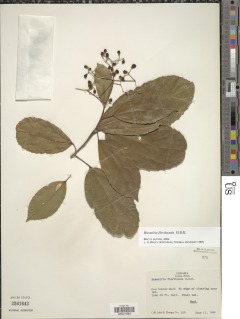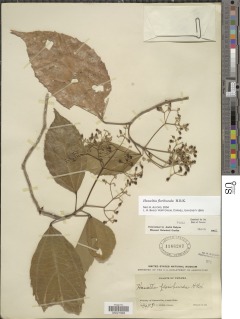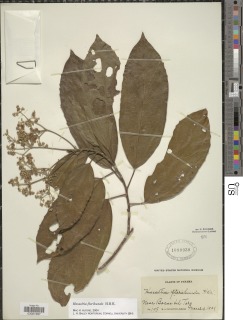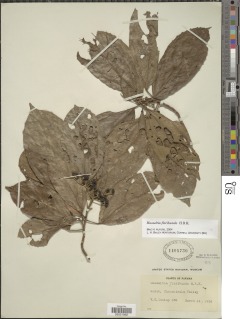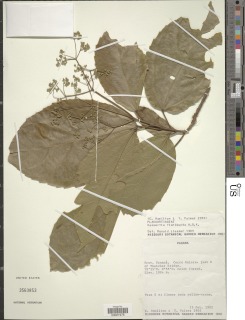

|
|
|
|
Family: Flacourtiaceae
Parimonton, more...raspa lengua
[Hasseltia rigida Woodson ex A. Robyns] |
Description: A small or medium-sized tree, frequently branched near the ground. Leaves are alternate and toothed, angled relative to the petioles. At the base of each leaf there is a pair of flattened, oval glands, adjacent to the petiole where it meets the leaf. The petioles are fairly long, and slightly swollen at both ends. Reproduction: Flowers are small, white, in clusters at the end of branches, produced during the dry season. Fruit are small red or purple berry that mature from April to June. Distribution: Very common in the central part of the isthmus, from Barro Colorado to Gamboa, in both secondary and old-growth forest. It is widespread elsewhere as well, but much less common and more restricted to edge sites or regenerating forest. Common along Pipeline Rd. and easy to see in flower there. Similar Species: Hasseltia is not confused with its relatives in the Flacourtiaceae, most of which has leaves arranged in a flat plane. It is confused with the remarkably similar LK alchco Alchornea costaricensis LK2 and LK alchla A. latifolia. LK2 Both Alchorea have toothed leaves with glands at the base. The venation of Hasseltia is quite different, though, with three veins arising at the base of the leaf and extending toward the leaf tip; in Alchornea, there are also three veins at the base, but the two secondary veins are smaller than the main vein and do not extend nearly as far toward the leaf tip. Descripción: Árbol de 5 a 20 m de alto. Tronco ramificado a baja altura. Corteza exterior marrón. Hojas simples y alternas, de 8-25 x 3-10 cm, oblongas o elípticas, con ápice acuminado, bordes dentados y base obtusa. Las hojas presentan un par de glándulas aplanadas en la base. Pecíolo de 1-4 cm de largo, pulvinados en ambos extremos y ligeramente acanalados en la parte superior. Flores blancas. Frutos en bayas globosas, de 0.4-0.8 cm de diámetro, verdes, tornándose rojos o negros al madurar. Datos Ecológicos: La especie crece a bajas y medianas elevaciones, en bosques húmedos o muy húmedos. En Panamá se encuentra en las provincias de Bocas del Toro, Chiriquí, Colón, Darién, Panamá y Veraguas. Común y fácil de observar en bosques del Canal de Panamá. Las hojas son atacadas por una especie de coleóptero que ocasiona un patrón de herbívoria muy distintivo. Florece y fructifica de enero a junio. Las flores son visitadas por abejas y otros insectos. Las semillas son dispersadas por animales, principalmente aves que se alimentan de los frutos maduros. Especies Parecidas: A menudo se confunde con LK alchco Alchornea costaricensis LK2 , pero en A. costaricensis las hojas tienen los bordes crenados, el fruto es una cápsula bilobulada con restos de los estigmas en la punta y las semillas son rojas. Usos: La madera es empleada para elaborar cajas, cajones, tableros, carpintería en general, construcción interna, formaletas, muebles, ebanistería, chapa y contrachapado de buena calidad. Raspa lengua, Parimontón Small tree, 4-20 m tall; trunk to 30 cm dbh, often forming stilt-roots when leaning; outer bark smooth, thin; inner bark tan, granular, streaked with harder dark areas; young stems, petioles, and midribs above sparsely pubescent. Petioles 1-4 cm long; blades +/- elliptic, acuminate, obtuse at base and with 2 green glands on upper surface, 7-22 cm long, 4-11 cm wide, coarsely serrate; palmate veins at base 3, with a second pair of lateral veins arising in apical half to two-thirds of blade. Umbels divaricately branched, often broader than long; inflorescence branches, pedicels, and flowers puberulent; flowers 4-parted; sepals acute at apex; petals white, narrowly spatulate, to 2.7 mm long, equaling sepals; both petals and sepals recurved at anthesis; stamens numerous, 3-4 mm long; ovary +/- stalked, nearly glabrous; style to 2 mm long; stigma simple. Berries subglobose, to 8 mm long, red turning dark violet-purple at maturity; seeds 1 or 2, to 5 mm long. Croat 7273. Common in the forest, especially the young forest. Flowers mostly in the dry season, but as late as June. Most fruits mature in the late dry and early rainy seasons. Plants may develop a second inflorescence from the base of the infructescence at about the time the fruits are maturing. Honduras to northern South America. In Panama, known from tropical moist forest in the Canal Zone, Bocas del Toro, Colón, Panama, and Darien and from tropical wet forest in Colón, (Portobelo). Reported from premontane wet and premontane rain forests in Costa Rica (Holdridge et al., 1971). |
|
|
|
































